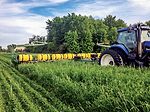Termination
Tips for Terminating Cover Crops Without Glyphosate
With the popular weed killer in legal straits in the U.S., no-tillers say they’d turn to other chemicals, rollers or other options. But most won’t give up on cover crops.
Read More




